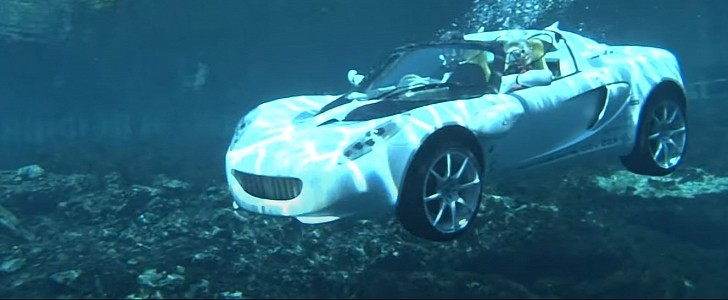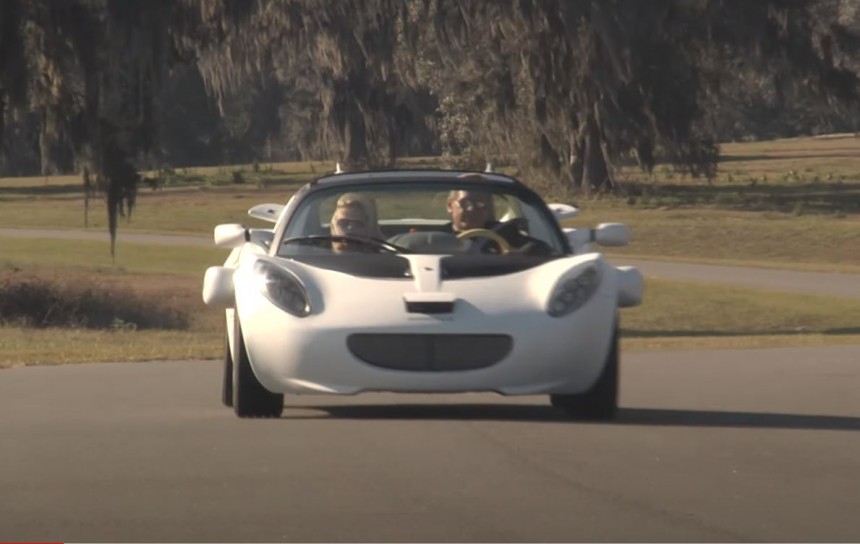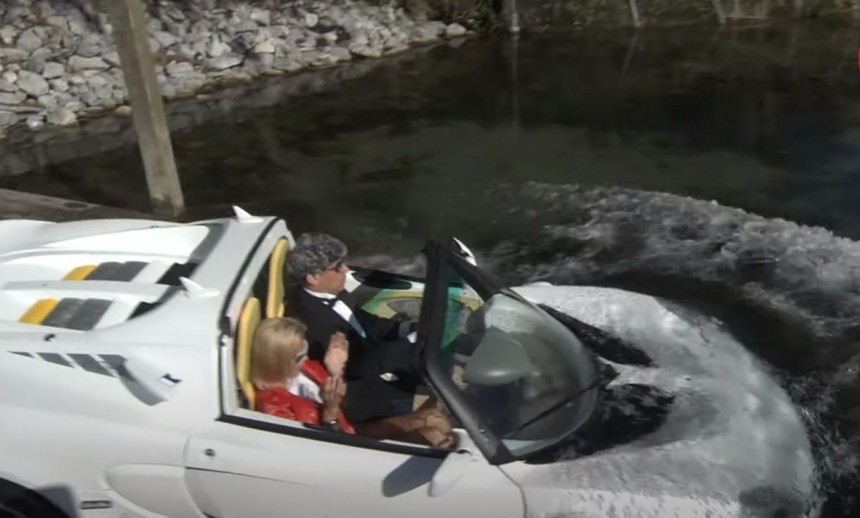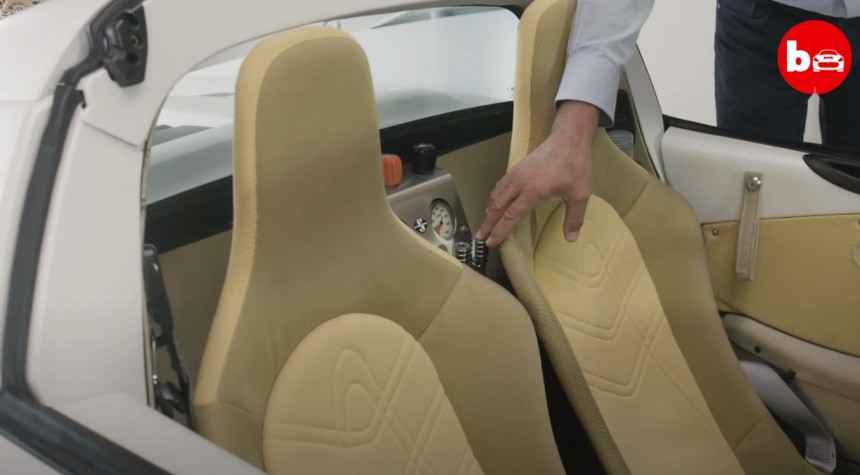Years before Elon Musk and Tesla completed the build on the Cybertruck and Musk started musing out loud on Twitter on whether it should float, an actual submarine-car was made. The sQuba, from Swiss mobility lab Rinspeed, remains the world’s only car to double as a submarine.
The sQuba is a concept car but it’s also a custom built, in that it’s actually a Lotus Elise minus the heart - the engine - and every other piece of tech inside. Rinspeed took nearly three decades to design and build the vehicle, which was unveiled at the 2008 edition of the Geneva Auto Show.
The inspiration for the sQuba was the same as with Musk’s Cybertruck: the Lotus Esprit driven by James Bond in The Spy Who Loved Me. Unlike that one, the sQuba features an open cockpit, because, as founder and CEO Frank M. Rinderknecht explains in the video at the bottom of the page, adding a roof would have added too much weight to the vehicle.
To be clear, amphibious cars do exist, but the sQuba stands out from the rest by being able to dive. In spite of the open cockpit, you can easily drive it off the road and into the nearest lake or even body of salted water, as long as you’re not particularly opposed to the idea of getting yourself wet. Or ruining your hair.
The sQuba features three electric motors, one for driving on land and two for moving around in water. While the exterior body remains that of a Lotus Elise, the interior has been stripped bare and redesigned, so as to allow it being submerged into water and take minimal damage from it. As such, the seats and everything else is made to get wet – and then to dry off incredibly fast.
Instrumentation has also been modified to include both driving and diving information, including speed, depth and water capacity. Since you could theoretically drive it into the ocean, that’s the last place you want to find out you’d run out of battery juice.
Because the cockpit is open top, behind the driver and passenger seat, there’s a pair of oxygen tanks and all the necessary piping for masks and regulators. The sQuba, much like the Elise it was based on, can only seat two.
sQuba can go from land to water with minimal fuss. It can float on the surface and go under, where it “flies” like a submarine, so you’re not driving it at the bottom of the lake or ocean, on the ground. Underwater, the driver controls it via the rear propellers and two Seabob water jets, while the exterior pods help it propel itself by pushing water. The sQuba only dives once the driver floods the cockpit with water.
On land, the sQuba can travel at speeds of up to 120 kph (75 mph), which is something that would make James Bond turn up his nose in disgust because it would be close to useless to him. On the bright side, it comes with a laser sensor system from Ibeo, which would allow autonomous driving. As shown in the other video below.
On the surface of the water, it moves at a speed of about 6 kph (3.2 knots or 3.7 mph), while diving is done at a speed of 3 kph (1.6 knots or 1.9 mph). Stabilized floating is possible at a maximum depth of 10 meters (33 feet). These are not impressive figures, but look at it this way: it would be slow enough to allow you to take in the amazing views, during an amazing and unique experience. Glass half full and all of that.
And then there’s this: there is only one sQuba in the world. Rinderknecht is now saying that he got several important offers from big players on the automotive market about bringing it to production, but he passed on them because scaling production would have been impossible and unsafe.
Back in 2008, after the Geneva debut, he was still entertaining notions of a mass-produced sQuba. While the working concept cost some $1.5 million to make, Rinderknecht said at the time a production model would be cheaper than a Rolls-Royce. But it would still be a rich boys’ toy, because appeal in it would be limited, he insisted.
That aside, the sQuba stands out for being a custom build / concept vehicle that proved the impossible can become possible with plenty of hard work and about 30 years’ worth of patience. Or, as Rinderknecht explains: “The idea came from James Bond, but it was fiction, it was Hollywood, it never really happened. So, our claim was to put all that fiction into reality. And we made it happen.”
The inspiration for the sQuba was the same as with Musk’s Cybertruck: the Lotus Esprit driven by James Bond in The Spy Who Loved Me. Unlike that one, the sQuba features an open cockpit, because, as founder and CEO Frank M. Rinderknecht explains in the video at the bottom of the page, adding a roof would have added too much weight to the vehicle.
To be clear, amphibious cars do exist, but the sQuba stands out from the rest by being able to dive. In spite of the open cockpit, you can easily drive it off the road and into the nearest lake or even body of salted water, as long as you’re not particularly opposed to the idea of getting yourself wet. Or ruining your hair.
Instrumentation has also been modified to include both driving and diving information, including speed, depth and water capacity. Since you could theoretically drive it into the ocean, that’s the last place you want to find out you’d run out of battery juice.
Because the cockpit is open top, behind the driver and passenger seat, there’s a pair of oxygen tanks and all the necessary piping for masks and regulators. The sQuba, much like the Elise it was based on, can only seat two.
sQuba can go from land to water with minimal fuss. It can float on the surface and go under, where it “flies” like a submarine, so you’re not driving it at the bottom of the lake or ocean, on the ground. Underwater, the driver controls it via the rear propellers and two Seabob water jets, while the exterior pods help it propel itself by pushing water. The sQuba only dives once the driver floods the cockpit with water.
On the surface of the water, it moves at a speed of about 6 kph (3.2 knots or 3.7 mph), while diving is done at a speed of 3 kph (1.6 knots or 1.9 mph). Stabilized floating is possible at a maximum depth of 10 meters (33 feet). These are not impressive figures, but look at it this way: it would be slow enough to allow you to take in the amazing views, during an amazing and unique experience. Glass half full and all of that.
And then there’s this: there is only one sQuba in the world. Rinderknecht is now saying that he got several important offers from big players on the automotive market about bringing it to production, but he passed on them because scaling production would have been impossible and unsafe.
Back in 2008, after the Geneva debut, he was still entertaining notions of a mass-produced sQuba. While the working concept cost some $1.5 million to make, Rinderknecht said at the time a production model would be cheaper than a Rolls-Royce. But it would still be a rich boys’ toy, because appeal in it would be limited, he insisted.















